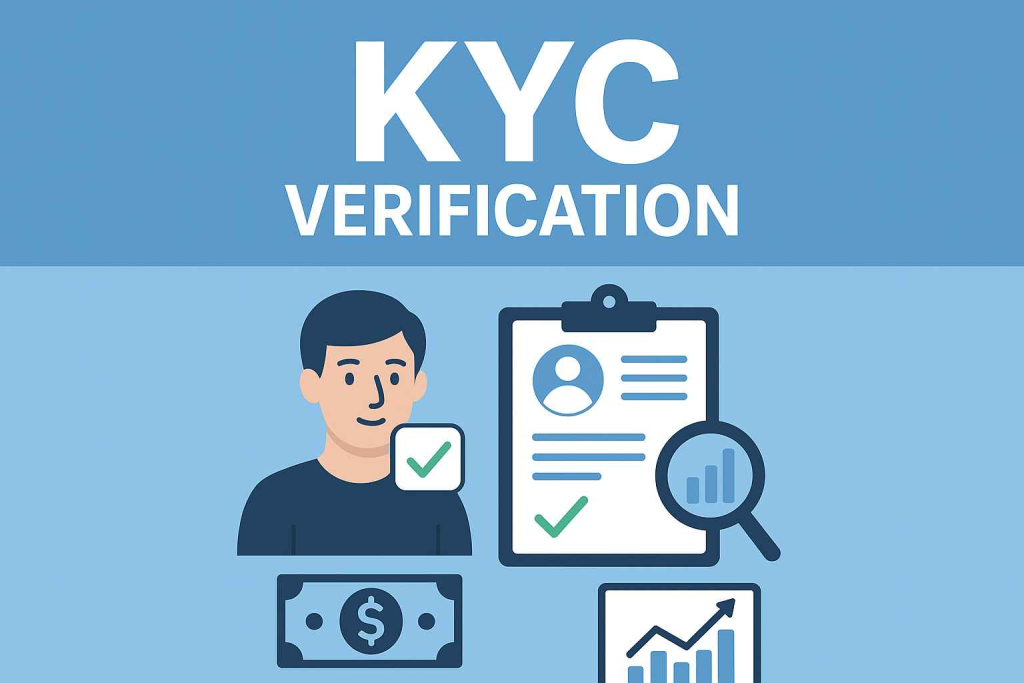KYC Verification: Strengthening Financial Integrity Through Identity and Transaction Monitoring

Table of Contents
Toggle
What is KYC Verification?
KYC verification, or Know Your Customer verification, is a mandatory process financial institutions use to confirm the identity of their clients. It helps banks, fintechs, and other regulated entities ensure that their customers are who they claim to be. The main goal of KYC verification is to prevent financial crimes such as money laundering, identity theft, and terrorist financing.
In today’s digital economy, where millions of transactions occur daily, understanding what KYC verification is is crucial for both businesses and customers. By conducting thorough identity checks, organizations can build trust, reduce risk, and maintain compliance with global regulations such as FATF (Financial Action Task Force) recommendations.
The KYC Process: Step-by-Step Identity Verification
The KYC process begins with gathering personal information from the customer. This typically includes full name, address, date of birth, and official identification documents such as a passport, driver’s license, or national ID card. The financial institution then cross-checks these details against various databases and regulatory watchlists to verify authenticity.
Digital KYC has simplified the process with advanced tools such as biometric verification, facial recognition, and AI-based data validation. Customers can now complete verification remotely, making the experience faster and more secure. Institutions, on the other hand, gain the advantage of automation and reduced manual errors.
Additionally, the KYC process often involves enhanced due diligence (EDD) for high-risk customers, such as politically exposed persons (PEPs) or businesses operating in high-risk jurisdictions. These measures allow financial institutions to understand their clients better and prevent suspicious activities from slipping through the cracks.
The Role of Proof of Income in KYC Verification
Proof of income plays a critical role in KYC verification, especially when assessing financial profiles for loans, investments, or high-value transactions. It provides insight into the customer’s financial behavior and ensures that their funds come from legitimate sources.
Documents such as salary slips, tax returns, and bank statements are commonly used to verify income. This step is essential in preventing illegal activities like layering or integrating illicit funds into the financial system. For example, if an individual claims to earn a modest income but deposits large amounts frequently, the financial institution may flag the account for review.
By integrating proof of income into KYC verification, organizations strengthen their risk assessment framework and align with anti-money laundering (AML) obligations.
Transaction Monitoring and Its Connection to KYC
While KYC verification focuses on identity, transaction monitoring tracks how customers use their accounts after onboarding. Both processes work together to ensure continuous compliance and detect unusual behavior.
Transaction monitoring systems analyze financial data in real-time, searching for patterns that may indicate suspicious activity. For example, sudden large transfers, cross-border remittances, or multiple small deposits below reporting thresholds could trigger alerts. These alerts are then reviewed by compliance teams to determine whether a Suspicious Activity Report (SAR) should be filed.
By combining KYC verification with transaction monitoring, financial institutions maintain a full lifecycle approach to compliance — from customer onboarding to ongoing surveillance.
Why KYC Verification Matters in Modern Finance
KYC verification is more than a regulatory requirement; it’s a cornerstone of modern financial security. Without it, the global economy would be vulnerable to fraud, money laundering, and corruption. Financial institutions that fail to implement effective KYC practices face not only reputational damage but also hefty regulatory fines.
Moreover, with digital banking and fintech platforms on the rise, KYC ensures a safer user experience. Automated KYC tools can quickly verify identities while maintaining compliance with local and international laws such as the EU’s AMLD, the USA PATRIOT Act, and the Financial Conduct Authority (FCA) guidelines in the UK.
For customers, KYC verification adds a layer of security by protecting their accounts from unauthorized access. It also builds confidence that the financial system operates transparently and ethically.
The Future of KYC: From Manual Checks to AI-Driven Compliance
The future of KYC verification lies in automation and artificial intelligence. Machine learning algorithms can now detect anomalies in real time, significantly improving accuracy and reducing compliance costs. AI-based identity verification tools can process documents, match faces, and cross-reference data across global databases within seconds.
Blockchain technology also offers new possibilities for KYC, such as decentralized identity systems where customers control their own data securely. These advancements promise to make the KYC process faster, more transparent, and less prone to human error.
Financial institutions are increasingly integrating transaction monitoring tools with AI-driven KYC systems to create a unified compliance ecosystem. This ensures continuous vigilance and real-time risk detection, aligning with the evolving global regulatory landscape.
Conclusion
KYC verification is the foundation of a secure and compliant financial environment. It not only helps institutions comply with AML and counter-terrorist financing (CTF) regulations but also protects customers from fraud and financial abuse.
By incorporating proof of income, transaction monitoring, and an efficient KYC process, organizations can safeguard both their reputation and their clients’ trust. As technology continues to evolve, the future of KYC will rely on intelligent automation — ensuring that compliance remains proactive, efficient, and effective in the fight against financial crime.
- Arts & Style (100)
- Automobile (288)
- Business (5,740)
- Business and Entrepreneurship (168)
- Career Development (55)
- Climate & Environment (26)
- Creative (34)
- Culture (1,562)
- Beauty (284)
- Skincare (243)
- Cultural Studies (75)
- Digital Life (73)
- Energy Healing (31)
- Fashion (1,040)
- Clothing (697)
- Fashion Design (234)
- Philosophy (7)
- Morality (6)
- Religion (17)
- Sports (116)
- Beauty (284)
- Digital Marketing (343)
- DIY and Crafts (15)
- Economics (8)
- Education (1,285)
- Entertainment (198)
- Faith & Spiritual (10)
- Fashion and Beauty (155)
- Finance and Money Management (211)
- Fitness and Exercise (32)
- Food and Drink (171)
- Game (142)
- Health and Wellness (1,099)
- Home and Garden (391)
- Law (144)
- Lifestyle (1,384)
- Health (685)
- Home (390)
- Architecture (100)
- Interior Design (216)
- Rental Property (27)
- Pets (76)
- Relationships (70)
- Restaurants (19)
- Literature (7)
- Media (273)
- Packaging (41)
- Politics (1)
- Real Estate (257)
- Science and Nature (14)
- SEO (141)
- Social Media Marketing (51)
- Software Development (227)
- Sports and Fitness (44)
- Technology (855)
- Artificial Intelligence (239)
- Blockchain (61)
- Data Science (114)
- Gadgets (145)
- Security (142)
- Transportation (111)
- Travel & Tourism (761)
- Uncategorized (2,018)
- World (62)
- International (59)
- How to Style Diamond Earrings for Any Occasion

- KYC Verification: Strengthening Financial Integrity Through Identity and Transaction Monitoring

- Absorb More Comfort with Towel Hub’s Soft Wholesale Towels

- Latest Nexa Vape Flavors and Pods: A Realistic Look at What’s New

- Top Benefits of Partnering with the Best Flutter App Development Company


KYC Verification: Strengthening Financial Integrity Through Identity and Transaction Monitoring

Deepfake Detection: Combating AI-Generated Manipulation with Liveness Detection

Custom CRM Solutions: Transforming the Way Businesses Build Relationships

MRI Shielding Companies | Innovative Shielding for Hospitals

How to Style Diamond Earrings for Any Occasion

KYC Verification: Strengthening Financial Integrity Through Identity and Transaction Monitoring

